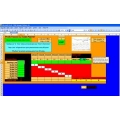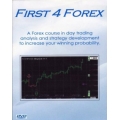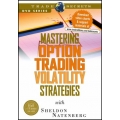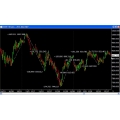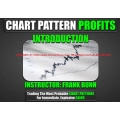Barry Rudd – Stock Patterns For Day Trading Study Course
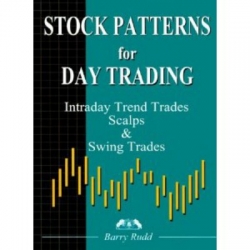 Click to enlarge |
|
Stock Patterns For Day Trading Home Study Course, Barry Rudd & Matt Rudd in 3 DVD + 10 hours of Level II quote screen tutorials
This Stock Patterns For Day Trading describes the trading strategies used by a professional stock trader in his own trading. The ideas come both from friends who are successful traders as well as his own experience with SOES trading. The collection of trading patterns described represents one of the first full-fledged books of instruction on short term, swing and day trading in individual stocks. The author’s intraday trend trading approach and his scalping method are both described in detail. He uses the setups daily in his own trading. This course should prove valuable to the thousands of short term stock traders who seek to make their living from speculating on short term price swings. It is a toolbox for finding high probability trades for success as you trade the stock market. The technical ideas are primarily crafted around the personality of the NASDAQ market but may also be implemented in New York trades.
VIDEO I (Introduction Module)
- Introduction to electronic direct access trading for stock day traders
- Overview of Investing, Swing Trading, and Day Trading
- The NYSE – structure of an “auction” market
- NYSE order routing with SuperDOT
- Role of the Specialist
- The structure of the NASDAQ market
- NASDAQ order routing
- Understanding ECNs (Electronic Communications Networks)
- Role of the Market Makers
- Basic terminology
- Understanding the Level II quote window
- Components of the basic screen layout for your computer
- What are price bar charts?
- The daily bar chart
- The 5 minute intraday bar chart
- Understanding how to use the stock ticker
- Order entry and management windows
- Tracking the market indices
- Using candlestick charts
- Summary
- Level II quote screen tutorial
VIDEO II
- Introduction to methodology section of course (for tapes 2 – 6)
- Why use price bar charts to day trade?
- Scalping vs. intraday trend trading – overview
- Find a trading style that fits your personality
- Know your exit price before you enter a trade
- The “Wiggle” – a detailed explanation
- How to determine the current wiggle for each stock you trade
- Generating a computer screen layout for your trading
- Navigating your tickers, charts, stock box and time and sales windows
- Interpreting your tickers
- Which indices to follow and why
- Utilizing the “new high, new low” ticker
- 5 minute bar chart patterns
- Consolidation breakout pattern – the dynamics
- Timing your entry with the Level II & time and sales to get the best entry price
- Spotting breakout patterns in advance
- Using another Level II window as a “launching pad” for trade entry
VIDEO III
- What constitutes consolidation – the 3 main criteria
- Tying the bar chart price to the Level II quote screen
- Interpreting the time and sales “prints” in relation to Level II quote movement as a way to uncover buying or selling pressure
- The Bull’s Horn pattern on the 5 minute chart
- Listening to the market and reacting – don’t force a trade
- Intraday wedge pattern
- Using the prior day’s intraday chart to enhance consolidation breakout trades
- Support and Resistance on micro and daily time frames – a visual indicator of potential halting points
- “Shotgun” pattern on the 5 minute bar chart with ensuing volume influx
- “L” pattern on the 5 minute bar chart
- Morning “Flashback” or headfake pattern
- Computer screen examples of 5 minute bar chart patterns
- Wide Range Day with Extreme Close – daily bar chart setup
- Wide Range Day with slight gap outside, slight gap inside, the opening even with prior day’s close, and the big gap open
- Trading off micro support and resistance zones on wide range days
- Large price gap plays on the daily bar chart
VIDEO IV
- More on large gap openings on the daily bar chart
- Computer screen examples of wide range day setups
- Reversal setups on the daily bar chart
- Intraday (5 minute bar chart) dynamics of the Reversal setup
- Where to enter and exit a reversal trade
- Scanning your daily charts to create a hit-list for the next trading session
- The alternative entry to the intraday consolidation breakout
- The dangers of “randomly” picking tops and bottoms of price swings intraday
- Variation on the initial wiggle to better minimize losses on a losing trade
- Daily congestion breakout plays – more stocks for the morning hit-list
- Computer screen examples of the Reversal setup
- Profit Targets – likely halting points to exit a trade:
- 1. Daily price support and resistance
- 2. Retracement of a Wide Range Day
- 3. Reversal setup profit target
- 4. 50 & 200 day simple moving averages
- 5. The closing of a price gap on the daily chart
- 6. Price spike on intraday chart
- 7. Significant reversal in direction of market indices intraday
- Filters – filtering out the best potential day trades
- 1. Too near a profit target
- 2. Beware of trading a stock during daily congestion
- 3. The cyclical nature of a stock’s “trader friendly” mode
- 4. Significance of the typical daily range of a stock
- Computer screen examples of profit targets and filters
- Summary – tying together all the trading analysis
- Trade checklist – 14 step flowchart process for evaluating, trading and managing high probability trades
VIDEO V
- Fading (counter trend trading) techniques – not randomly picking tops and bottoms, but using specific criteria instead
- Profit target reactions
- “Tagging”
- “Big Stack and a Rainbow”
- NASDAQ Level II quote screen – a fuller understanding
- Using 4 key factors to gauge the risk of a stock
- 1. The bid/ask spread
- 2. Number of Market Makers and ECNs per price level
- 3. Number of shares posted by each Market Maker and ECN
- 4. The price difference between each “price level”
- How a Market Maker can act as the “ax” or “hammer” in a stock
- Relative Strength – daily and intraday – one of the most important factors in your trading decisions
- Market Indices – the trend vs. the immediate direction on the 5 minute chart
- Micro support and resistance on the indices
- Typical market index behavior – morning move, mid-day, and afternoon move
VIDEO VI
- Computer screen index examples of relative strength
- Time of day – finding the best times to trade (and the ones to avoid)
- What stocks to trade – how to choose your basket of stocks
- Trade analysis – trading as a business
- Managing your trading vs. just managing a trade
- Money management – a three step approach to help minimize risk and lock in profits
- IPOs and news trades
- Scalping profitably – beware the pitfalls
- The art of trading
- Some footage of “live trading”
The “Stock Patterns for Day Trading Home Study Course” retail at $495.The training seminar cost $3,000. This Course were Sold out at the author’s website.
Proof of content,please see the images
Delivery to your PayPal email address within 24 Hours of payment confirmation.
Barry Rudd – Stock Patterns For Day Trading Study Course
To buy without signing in contact us here:
Market Sales Price: $1199,but we sell lot more lower than that to share the opportunity with you!
A. Product Quality
- We ensure that the quality of the course is good, and we update them regularly to help you keep update.
- If there is a problem you can not use, please let us know so we can fix it soon or if there is any notification, we will inform you immediately.
B. Shipping Method
- After receiving your payment, we will send you a link to access and download the course. If our team is not in the office, please wait for us about 8 hours to come back.
C. Refund Policy
We do not accept refund after you got the link and download the course.
We will refund your money in case of:
- Item is not as described
- Item doesn’t work the way it should
- Item support extension can’t used
Serving Professional Traders Since 2008
Once purchased I will email you the files within 20 minutes and not more than 48 hours to your email, if there a delay, please be patience receiving your files
Your Review: Note: HTML is not translated!
Rating: Bad Good
Enter the code in the box below:

 Categories
Categories Information
Information Specials
Specials




-38x38.jpg)

-38x38.jpg)
-38x38.jpg)
-38x38.jpg)
-38x38.jpg)
-38x38.jpg)

-38x38.jpg)



-38x38.jpg)


-38x38.jpg)
-38x38.jpg)
-38x38.jpg)
 Featured
Featured

























 Shopping Cart
Shopping Cart Bestsellers
Bestsellers






-38x38.jpg)































-38x38.jpg)






